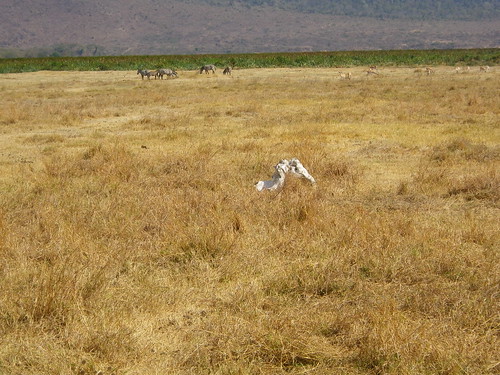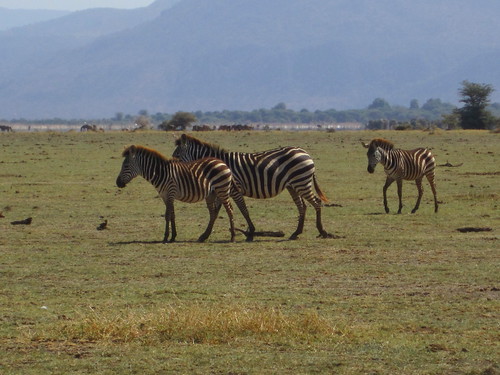
As I said before, David was born on the slopes of Kilimanjaro. His father was a policeman initially in the Kilimanjaro area, but later was "promoted" to the big leagues in Arusha, and took David with him.
During this time, David received both public primary and secondary schooling, more or less paid for by the Tanzanian government. This is important because while primary schooling is basically free (e.g., students have to pay for uniforms, testing fees, school supplies), secondary schooling is not. However, there are some notable exceptions in northern Tanzania that I am not sure are available in the rest of the country.
The first exception is for Maasai. For generations, even with "almost free" education, few Maasai children enrolled in schools because of their nomadic nature. The government had enough trouble keeping track of them without addresses, identification, etc., let alone put them into a stable school environment. As the years have progressed, however, the government has used various incentives to break the Maasai of their wandering ways, and one of them is to provide their children with free secondary education at a set location. While not widespread, the number of such children being schooled is steadily growing.
The second exception is to fight poaching. Yes, poaching. For most of Tanzania's history, poaching, especially of the Big Five, had been a serious problem. While the first line of defense were the Tanzanian park rangers, because they were under-paid and ill-equipped, not only could the poachers run circles around them with superior equipment, but many of the rangers were susceptible to bribes, and thus in cahoots with the poachers. Thus, to combat these poachers, who were basically taking the Big Five to extinction, risking the tourism industry, the government fought back on several fronts. One of them was to significantly increase incentives to the rangers, including providing free schooling for their children.
Even with a professional ranger corps, however, the government was still finding it difficult to significantly curtail poaching. So, they decided to go a little deeper, and attack the support network of these poachers, i.e., the surrounding community. Remember, while the park fees are significantly discounted for Tanzanian citizens, it is still too expensive for many, and so most have never been inside one of the national parks. Thus, what is self-evident to us was elusive to the normal Tanzanian: that the animals in the park had greater value to the community alive...


... rather than dead.



Okay, so maybe they do have some uses dead.
But the point is, if you were normal Tanzanian who lived next a national park, had never been inside, lived in poverty with no tangible benefit for protecting the animals (indeed, they were kind of pests, as monkeys stole food, predators ate livestock, and elephants... well, just did what elephants do), and the only money you saw in connection with the animals was from the poachers, who were you to bite the only hand that fed you?
Accordingly, the government embarked on a massive education campaign to explain the tourism value of these animals to the masses, and a big part of that campaign was to provide free secondary education to the children of families who grew up directly around the park, without whose tacit approval the poachers could not operate. And while this by itself was not the silver bullet, when combined with things like the ivory/rhino horn trade ban, incentives to create local tourism related businesses, and more hiring of locals for park jobs, poaching (at least of the Big Five) is today essentially non-existent. In fact, the government recently announced that it would re-institute a hunting ban on most public lands, as they figured out that they could collect more fees by making current game reserves into parks.
In any case, that is how David got his secondary education; by being the son of policeman in a tourism dependent town. As we drove out to Lake Manyara, David pointed out the differences between the public schools and the private schools, and they are about what you would expect in Tanzania. The public schools were simple buildings with a dirt "field" overrun with scores of happy children playing in uniform. The private schools were veritable compounds, surrounded by high walls, and catering to the small massively-wealthy portion of the populace.
So, after completing his secondary education (completed by most at the age of 15), David enlisted in the army. In Tanzania, everyone (except for, you guessed it, the Maasai) must serve in either the army or national service (think AmeriCorps or the Civilian Conservation Corps). David said he chose the army because its actually easier (a lot of national service involves heavy manual labor), Tanzania really isn't at war, and the time commitment is a few months shorter. We passed by an army base at one point, which was just a bunch of buildings surrounded by barbed wire on a dirt plain with nothing else for miles all around. And considering their entire budget is about 20 million dollars (yes, million with an M, not B), I don't think they were hiding any tanks.
After the army, David came back to Arusha and did what any mildly ambitious man did in Arusha; he tried to break into the tourism industry. Through family Chagga connections, his first job was a porter on Kilimanjaro. After doing this a few times, he decided the people who did this were insane, and so he went to a trade school to learn how to be a safari guide.
The school taught everything that the industry wanted in a safari guide: knowledge of animals, birds, park histories, weather patterns, and mostly importantly, languages. In order to get your first job as a safari guide, you had to be "safari fluent" in two languages, English, and something else. David chose Italian over the more obvious French and German to set himself apart. And let me tell you, he made me do a double take when he did his fluent-as-far-as-I-could tell mafiosa impressions. Once you broke in with one company, he said it was relatively easy to get other jobs, especially if you were good, as the industry was very tight-knit and word traveled fast. David hopes to save enough money to one day open a gym. God speed.
Which brings us back to Lake Manyara, and animals.


I showed you some baby elephants before, so here are some baby baboons. Super cute.

This woodpecker-ish guy kept hanging around our lunch site, waiting for us to drop some food.

That pink haze you see are flamingos on the edge of the lake. You actually can't get that close to them for a variety of reasons, so you will see a lot of pink hazes in future photos as well.




I think the top one is a dik-dik, the middle ones show impalas, and the bottom one has Thomson's gazelles, but I can't really be sure. There were a ton of little deer-like animals we saw which kind of all ran together in my brain after awhile.


Zards.

A blue... blue, blue, blue... monkey.


Are we in N'awlins yet?


These vulture looking things were kind of freaky.

This was my first panorama. It's from the picnic site where we ate lunch. It shows kind of the thickness of the brush we went through where we saw most of the animals.



Views of Lake Manyara from higher elevation. We actually took these a couple of days later on our way from Ngorongoro to Tarangire.

Notice the plethora of typical safari trees, like the one above. From there, we headed to the shores of lake, and specifically, next to the hippo pool.


This was the view from the hippo pool. As you can see, the animal concentration is a lot higher, with the mountains beautifully emerging from the lake on the right side.


The floodplain was awesomely massive.



It had HUNDREDS of zebras and wildebeests. I'll spare you the pictures of most of those on this go around, as the other parks actually had orders of magnitude more than Manyara. Although this one is too good not to share:





Fun facts: hippos kill more people than any other animal. David says they don't particularly go looking for trouble, but that when people go to the Nile for water, some inevitably either (1) run into one while crossing the middle of the river (especially at night) or (2) get between a beached hippo and water, which is a big no-no.

I leave you with a contemplative Rex.
Suffice to say, our day in Manyara was a complete success, with the exception of the fact that we didn't see a tree lion. David said they are (unsurprisingly) very hard to spot, especially during the day, because they just look like particularly thick, dark branches. I will show you what I mean when we play a game of "which tree actually has a leopard" when we get to Tarangire...
baby elephant!!!
ReplyDelete